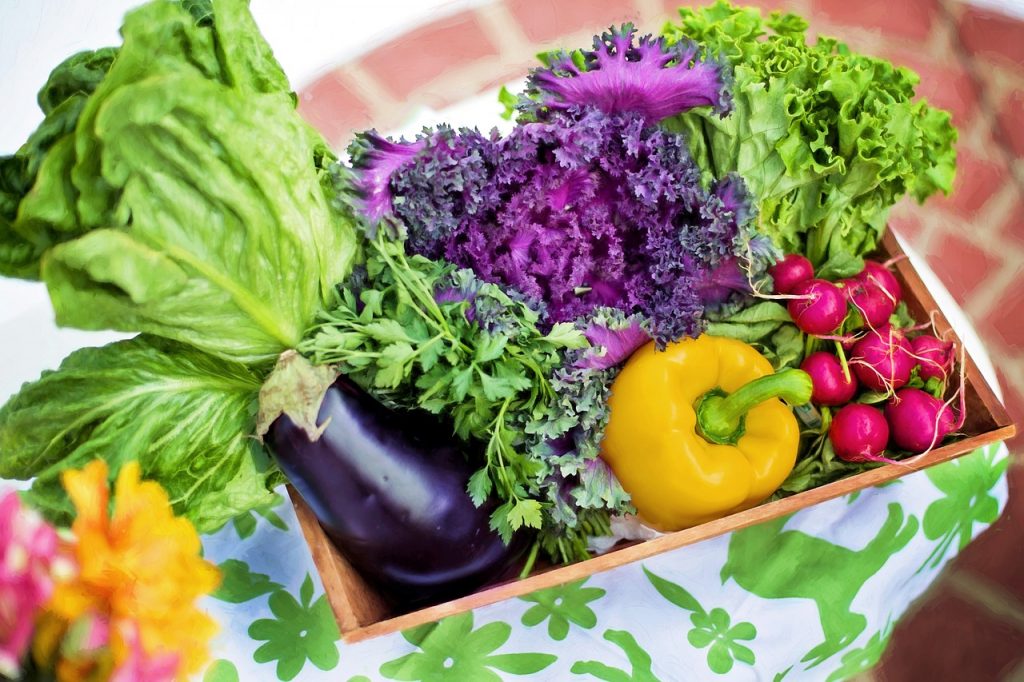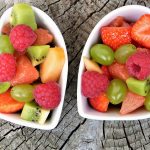What foods are high in fiber, How much fiber do you need?
High-Fiber Foods. What foods are high in fiber, How much fiber do you need?
How Fiber Keeps you Full, Aids Weight Loss, and Improves Health
Most people associate fiber with bodily functions and digestive health. But eating foods that are rich in dietary fiber can do much more than keep you regular. It can lower your risk of having heart disease, diabetes, and stroke. It can also improve your skin health and help you lose a pound. It may even help prevent cancer.
However, many do not eat enough. By using these effective tips to incorporate more fiber into your diet, you can prevent such diseases while looking and feeling your best.

What is fiber?
Also known as roughage, fiber is a part of plant-based foods that the body cannot break down. Good sources are grains, vegetables, beans, nuts, and fruits. Once it passes thru the body, it can keep your digestive system healthy and clean. You can say bye to bowel movements, cholesterol, and other harmful carcinogens.
Fiber is divided into two varieties such as insoluble and soluble.
Soluble fiber dissolves in water. It helps control the level of blood sugar and reduce cholesterol. Excellent sources include oatmeal, nuts, beans, and barley. Fruits are also loaded with soluble fiber. These are apples, citrus fruits, pears, and berries.
Insoluble fiber does not dissolve in water. It is also called as the bulky fiber that helps your digestive system prevent constipation. Typically, it is found in wheat cereals, whole grains, and other veggies such as celery, tomatoes, and carrots.
A lot of foods contain both insoluble and soluble fiber. Generally speaking, the more unprocessed the food, the higher it is in fiber. There is no fiber in sugar, meat, and dairy. White or refined foods, on the other hand, do not fiber as well.
Some of the health benefits
Studies indicate that nine out of ten Americans do not eat enough fiber. And people across the globe also fall short. Part of the dilemma may be due to the association between bathroom habits and fiber.
Yes, fiber provides an effective and healthy way to stay regular. But that is not the single reason why you should include it in your diet. Recent studies have highlighted how eating a fiber-rich diet can boost your immune system and improve your overall health.
Below are some of its health benefits:
Digestive health. Dietary fiber can normalize bowel movements. They do not only bulk up stools but also make them easier to pass. It can help relieve and avoid constipation and diarrhea. Eating enough fiber can likewise reduce your risk to acquire diverticulitis, gallstones, hemorrhoids, and kidney stones. It can provide relief for irritable bowel syndrome.
Other studies have shown that a diet with a high fiber may help to prevent gastroesophageal reflux disorder and lower gastric acid.
Heart disease. Soluble fiber is a key element for those people with a heart-healthy diet. Eating a diet that is high in soluble fiber can lower LDL cholesterol. A good intake can likewise protect you from metabolic syndrome. It is a group of risk factors that have been associated with coronary heart disease, stroke, and diabetes. Plus, fiber can normalize blood pressure, reduce inflammation, and improve levels of good cholesterol.
Diabetes. A high-fiber diet, specifically insoluble fiber can make you strong enough to withstand type 2 diabetes. In case you already have diabetes, soluble fiber can slow sugar absorption and boost the level of your blood glucose.
Cancer. Some studies suggest that having a high-fiber diet can prevent colorectal cancer. Diets that are packed with fiber-rich foods have been linked to lower the risk for further digestive system cancers including stomach, pharynx, and mouth.
Skin health. When fungus and yeast are excreted thru the skin, it can lead to acne. Eating fiber like psyllium husk can flush toxins out of the body, enhancing the appearance and overall health of your skin.
Fiber and weight loss
Aside from preventing constipation and aiding digestion, incorporating a bulk of fiber into your diet will ensure you to lose weight and maintain a healthy figure. It can help you feel full. Since it stays in the stomach within a long span of time, the feeling of fullness will remain with you over a long time as well.
High-fiber foods such as veggies and fruits are low in calories. So adding fiber to your diet, you can cut calories easily. Here are the other ways that a fiber intake can help weight loss:
- By regulating the level of your blood glucose, fiber can maintain the fat-burning capacity of your body and reduce insulin spikes. As a result, you will not feel drained nor eager to crave unhealthy foods.
- Eating fiber can move fat thru your digestive system at a quicker rate.
- When you consume fiber-rich fruits, you will have the energy to do a workout routine.
How much fiber do you need?
Recommended daily intake
| Age | Male | Female |
| 9-13 | 31 | 26 |
| 14-18 | 38 | 26 |
| 19-30 | 38 | 25 |
| 31-50 | 38 | 25 |
| 51-70 | 30 | 21 |
| Over 70 | 30 | 21 |
Source: Food and Nutrition Information Center, USDA
Tips for incorporating fiber into your diet
Depending on your age and gender, experts recommend you eat from 21 to 38 grams of fiber every day for maximum health. Research recommends that many people do not eat half that amount.
Although hitting the target may look cumbersome in the beginning, by filling up on veggies, fruit, and whole grains, you can get enough fiber and reap countless health benefits.
Making the switch to a fiber-rich diet
If this is your first time to eat high-fiber foods, it is a brilliant idea to start by gradually adding fiber to your diet and doubling water intake. Fiber absorbs water. So, the more fiber you include in your Diet, the more liters of water you should drink.
However, a sudden addition of a large amount of fiber can cause potential side effects, including intestinal gas, diarrhea, abdominal cramps, and bloating. The good thing is that these would go away once your system becomes used to it. For you to avoid discomfort, drink plenty of fluids.
Fiber from whole grains
Processed or refined foods do not have enough fiber. So, give whole grains a try and make it an essential part of your diet. Below are some simple ways to add whole grains to every meal you consume:
Start your day with fiber. To boost the amount of fiber intake at breakfast, take advantage of whole grain cereals. Switch your cereal from corn flakes to bran flakes. It can add six grams of fiber to your diet. Plus, switching to Fiber-One or All-Bran will boost it more.
In case you do not like the texture, and aroma, add a tablespoon of wheat bran to achieve your desired taste. Just use the unprocessed product for your safety and comfort.
Replace white rice, bread, and pasta with brown rice and whole grain products. Experiment with whole-wheat pasta, barley, wild rice, or bulgur. These good alternatives are loaded with fiber compared to their counterparts. Also, pick whole grain bread for sandwiches or toast.
Bulk up your baking. Have you been baking for the past few days? And do you crave for a different and delicious cake? Whatever the case may be, why don’t you try whole-grain flour? With a cup of this flour, you will achieve the result you desire the most.
When it comes to bread, use more yeast or let the dough rise for a few hours. Try adding unprocessed wheat bran or crushed bran cereal to cakes, cookies, and muffins. Or add more psyllium husk to bread, pasta, pizza dough, and other gluten-free baked goods.
Add flaxseed. Flaxseeds are brown seeds with great content of omega-3 fatty acids and fiber, lowering cholesterol in the blood. You can likewise grind the seeds in a food processor for your yogurt, breakfast cereals and applesauce.
Fiber from fruit and vegetables
Many vegetables and fruits are rich in fiber, which is a good reason to include in your diet. Below are a few techniques that can help:
Add fruit to your breakfast. Berries have a good content of fiber. So, add fresh raspberries, blueberries, blackberries, or strawberries to your cereal or yogurt.
Keep fruit and vegetables at your fingertips. Right after buying fruits and veggies, wash and put them in the fridge for quick snacks. Pick recipes that feature fiber-loaded ingredients such as fruit salad and veggie-stir fries.
Replace dessert with fruit. Instead of ice cream or a bar of chocolate, it is best to eat fruits, including apples, pears, and banana. You can also top it with frozen yogurt or cream for a yummy treat.
Eat whole fruits instead of drinking fruit juice. By eating whole fruits, you will get a higher amount of fiber or consume fewer calories. For instance, an 8 oz. glass of juice contains no fiber and 110 calories. A piece of orange juice, on the other hand, has 3g of fiber and 60 calories.
Eat the peel. Peeling can lower the content of fiber in vegetables and fruits. So, eat their peel such as pears and apples.
Incorporate veggies into your cooking. Add fresh vegetables to soups or even sauces. For example, mix pre-chopped broccoli into spaghetti sauce. Or toss baby carrots into other meals.
Bulk up soups and salads. Transform a dull salad by adding seeds, peas, black beans, peas, or nuts. Artichokes are likewise high in fiber that is a perfect ingredient for salads. But they can be eaten as a snack as well.
Don’t leave out the legumes. Add lentils, kidney beans, or peas to soups. When it comes to a green salad, the addition of black beans is a brilliant idea.
Make snacks count. Dried fruit, whole-grain crackers, or raw vegetables are an effective way to add fiber at snacks. Also, nuts can make a high-fiber snack.
Choosing fiber-loaded foods
Label lingo
A label can claim whether or not a food is a good source of fiber when it delivers at least 10% of your daily dose. When a product has two or more grams of fiber per serving, the terms “rich in,” or “an excellent source of” are allowed. Spooning up a bowl of fiber-loaded cereal is one of the best ways to reach your target. Just look for brands with 6 grams of fiber per serving.
Some good sources of fiber
| Cereals | Serving size | Fiber grams |
| Fiber one | ½ cup | 14 |
| Cooked oatmeal | 1 cup | 4 |
| Shredded Wheat | 1 cup | 6 |
| Bran Flakes | 1 Cup | 7 |
| All-Bran | ½ cup | 10 |
Vegetables
| Cooked spinach | 1 cup | 4 |
| Brussels sprouts | ½ cup | 2 |
| Broccoli | ½ cup | 3 |
| Carrots | 1 medium | 2 |
| Green beans | ½ cup | 2 |
Baked goods
| Whole-wheat bread | 1 slice | 3 |
| Rye bread | 1 slice | 2 |
| Rice cakes | 2 | 1 |
| Bran muffin | 1 | 2 |
Cooked legumes
| Kidney Beans | ½ cup | 6 |
| Canned baked beans | ½ cup | 5 |
| Green peas | ½ cup | 4 |
| Lima beans | ½ cup | 6 |
| Lentils | ½ cup | 8 |
Cooked grains
| Bulger | ½ cup | 4 |
| Barley | 1 cup | 9 |
| Brown rice | 1 cup | 4 |
| Wheat bran, dry | ¼ cup | 6 |
| Spaghetti, whole wheat | 1 cup | 4 |
Fruit
| Orange | 1 medium | 3 |
| Pear | 1 medium | 6 |
| Banana | 1 medium | 3 |
| Apple | 1 medium | 4 |
| Fresh strawberries | 1 cup | 4 |
Dried fruit
| Plums | 3 | 2 |
| Prunes | 6 | 12 |
| Dates | 3 | 2 |
| Apricots | 5 halves | 2 |
| Raisins | ¼ cup | 2 |
Nuts and Seeds
| Filberts, raw | 10 | 1 |
| Peanuts, dry roasted | ¼ cup | 3 |
| Peanuts | 10 | 1 |
| Walnuts | ¼ cup | 2 |
| Popcorn | 1 cup | 1 |
Adapted with permission from Harvard Heart Letter, published by Harvard Health Publications.
The fiber in instant food
Fast food is known for optimal convenient and cheap price. But finding a healthy and delicious meal with fiber can be a huge challenge. Most fast food meals are packed with sodium, unhealthy fat, and calories with no dietary fiber. Even a healthy salad from a restaurant does not have enough fiber.
Lettuce greens provide 0.5 grams of fiber per cup. So, it is best to look for salads that contain other vegetables such as corn, nuts, and beans.
Other tips for getting more fiber from meals at fast food restaurants:
- Choose burgers, subs, or sandwiches that come on a whole grain bread or whole wheat bun.
- Give a veggie burger a try.
- Choose a side of beans for a healthy and reliable fiber boost.
- Select salad or nuts over potato chips of fries.
- Combining a side of chili and a baked potato can make a high-fiber and tasty meal.
- Several restaurants provide oatmeal bowls for breakfast. These are a more excellent choice than other breakfast sandwiches.
- Finish a meal from fast food chains with a fruit cup, apple slices yogurt parfait, or fresh
Fiber supplements
Getting fiber from foods such as fruits, veggies, beans, nuts, and whole grains are expensive and difficult. As a good alternative, fiber supplements will be of huge help. These can also be helpful to top up your fiber intake. Plus, these products can help your transition to a fiber-rich diet simpler than expected.
Fiber supplements are available in different forms, including wafers, chewable tablets, or powders you dissolve in water. Nevertheless, there are a few drawbacks to getting your fiber from these supplements: here are some:
- Fiber supplements do not offer the same minerals and vitamins offered by fresh or organic foods.
- They do not fill you up or even manage your weight loss.
- They can interact with other medications such as antidepressants, the anticoagulation drug warfarin, and cholesterol-lowering medications. Always consult a specialist for your safety.
In case, you decide to use a fiber supplement, start with small amounts to avoid abdominal bloating. Moreover, drink plenty of water.
Photo sources: pixabay.com


